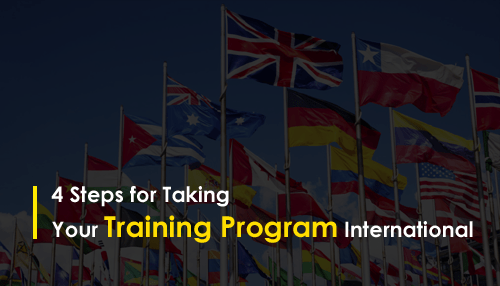When developing an e-learning or training program for a global audience, it’s important to prepare. Taking steps to accommodate the future translation of your content will save you a lot of time, effort, and money in the long run.
Obviously, different types of content will require a different approach. That said, the framework listed here can apply to any training or e-learning program your organization might develop. Follow these steps to ensure the process runs smoothly.
1. Start by Deciding on What Type of Content to Create
Before you even begin prepping for globalization, you need to consider what your overall goals are as an individual or an organization. This will help you decide on what kind of training content to create.
Next, consider the potential audiences you may have to adapt your content for. The more “feature-rich” an e-learning program is, the more work you’ll have to do adapting it and conducting elearning translations.
Understand that some training formats might not be appropriate for every single ethnicity, language, or culture. Reaching out to the kinds of people you’ll be adapting your program for can help you better understand what will and won’t work.
2. Develop a Basic Globalization Strategy
Once you’ve determined what type of content you plan on developing, you can start working on the basics of your globalization strategy.
Account for legal and cultural differences to ensure that all your training content will be relevant for all intended audiences. You should also keep in mind that any technology your program uses should be compatible with similar technologies in any other regions you may be targeting.
It’s important to understand that different cultures, even within a single country, may favor different learning styles. Research the ways people in your target cultures absorb information. Try to develop training content that adheres to their preferred learning styles.
This stage is the best time to start looking into translation firms you can enlist to help translate your content into other languages. You need to work with efficient, experienced professionals. You don’t want to rush to hire someone once you’re finally ready to translate your program.
Finally, establish a means of receiving feedback from your audience. If you run an organization, coordinating with the HR directors of your international offices is a smart idea. You want your audience to let you know if a certain approach isn’t working.
3. Develop Your Content
You can actually begin developing your e-learning program once you have established a reliable globalization strategy.
No matter what language you’re developing content in, try to keep instructions as simple and straightforward as possible. This will make it easier to translate later. Avoid making cultural references that won’t be relevant to all learners.
From a design perspective, you should remember that when text is translated into other languages, the overall formatting can change dramatically. Try to design your program with flexibility in mind, using elements you can alter efficiently if need be.
Use the active voice whenever possible for language in both the written and audio sections of your program. Also, avoid abbreviations and long sentences.
For the best results, start coordinating with a translation firm to find out how clear or unclear your content would be in different languages. They can help you avoid potentially confusing sentence structures or word choices.
4. Offer Your Content Globally
If you’ve developed an e-learning program as a means of training overseas employees, delegate responsibilities to other individuals within the company to ensure releasing your globalized content to various foreign markets is a simple, easy task. You need people to introduce the program to foreign markets, people who can remain in communication with those markets should problems arise, and team members responsible for coordinating with your translation firm of choice.
Don’t rely on in-house personnel to actually translate the program. Hiring experienced professionals helps you save money in the long run. Correcting mistranslations is costly; that’s not something you have to worry about when you rely on experts.
Again, depending on the nature of your e-learning program, your globalization process may require certain unique steps. However, the ones listed here serve as an excellent foundation, regardless of your specific goals. By following them and working with experts, you’ll develop an effective e-learning program that’s easily translated.



